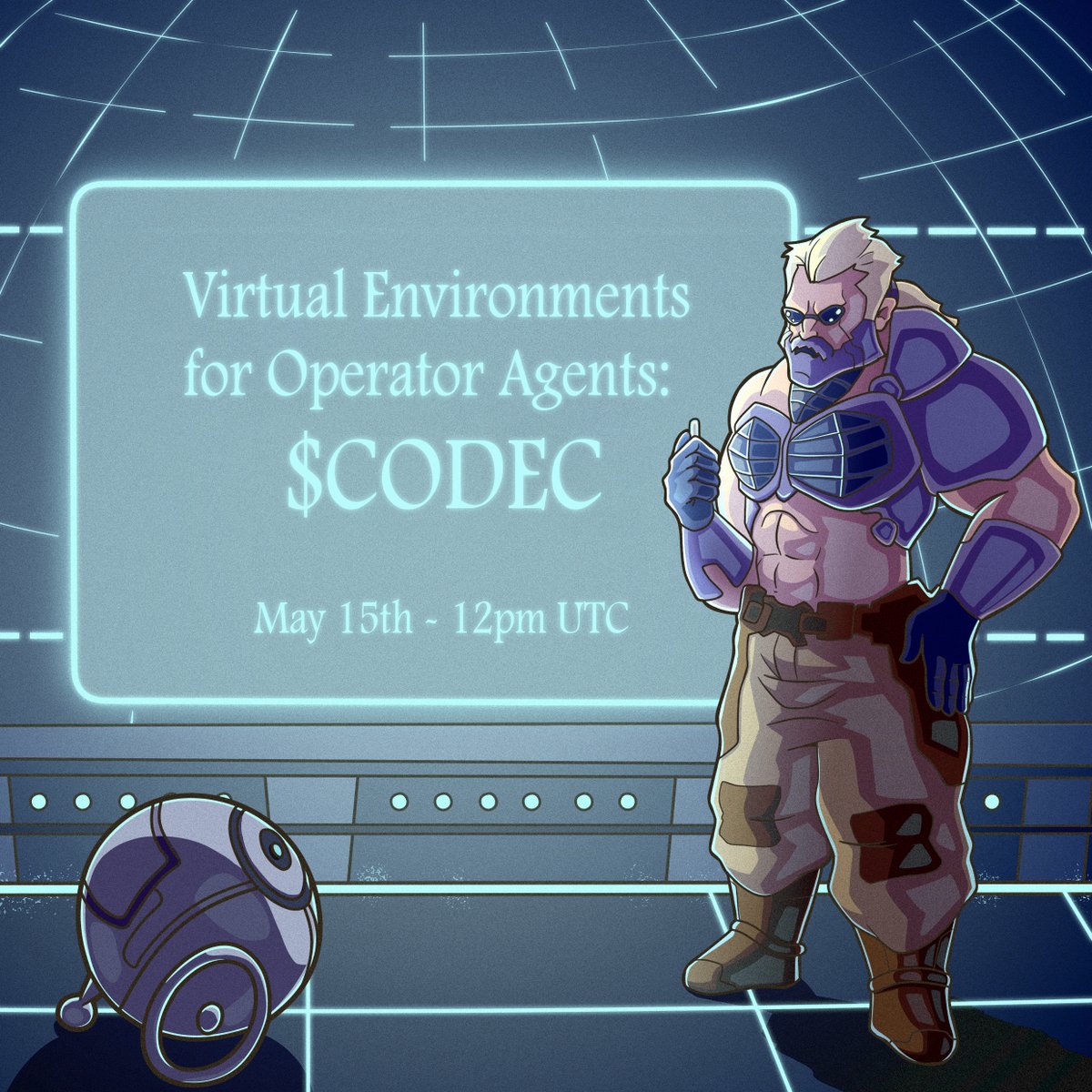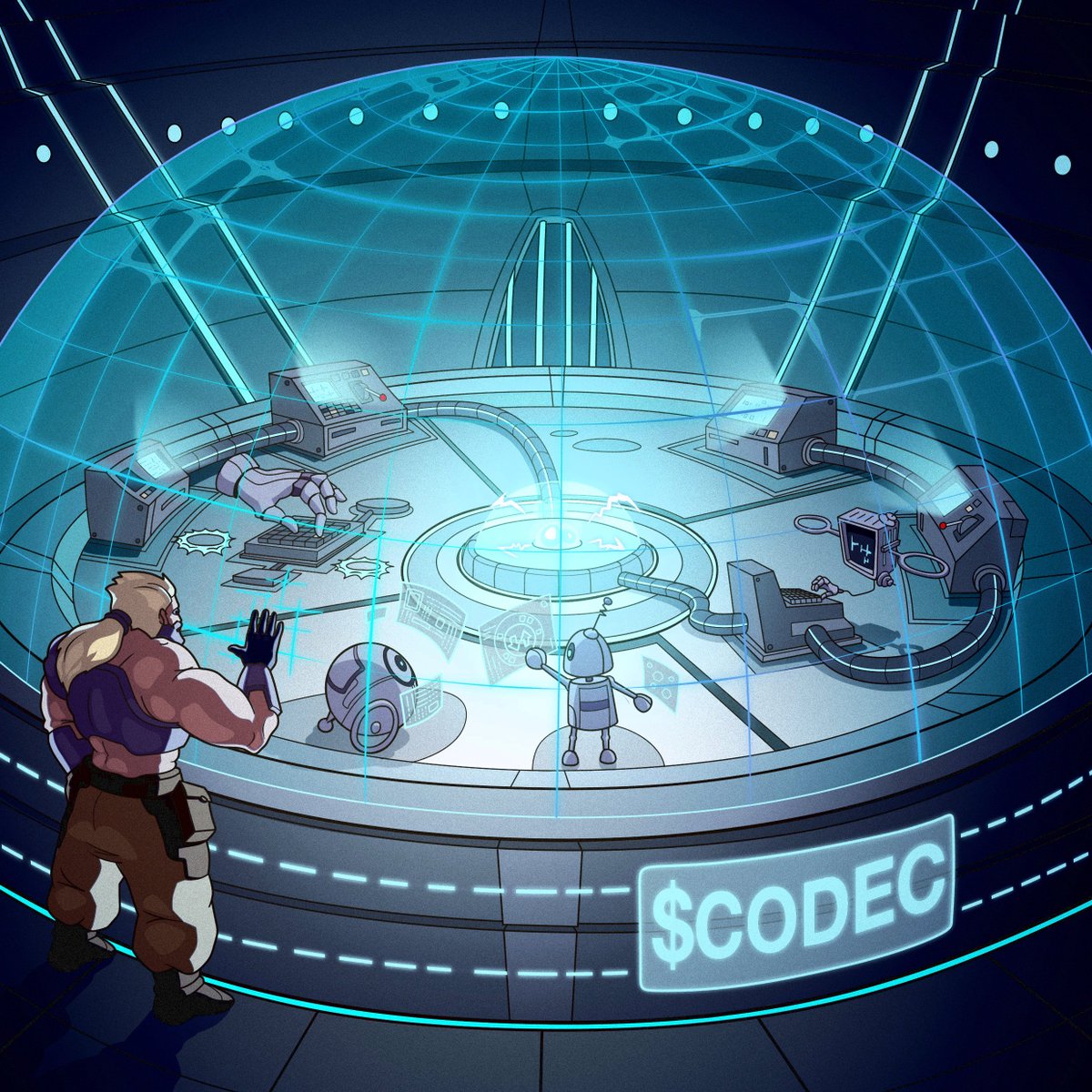
$0.002046
0.00001296 SOL
-10.26% (24h)
Market Cap
$2,046,096
Liquidity
$171,952
Holders
1,084(Top 10: 37.13%)
Blockchain
Solana
Contract Address
69ljzuuzxj3cb3fxeo1x4qpyeqtboapkhxtysppbpump
AGE
46 days (Apr 24, 2025)
DEXes
Pumpswap, Meteora
About Codec Flow
The name CODEC originates from the groundbreaking GUI-Actor paper by Microsoft, which introduced 'codec flow execution logic' enabling coordinate-free semantic GUI operations by AI agents. The token powers an action-oriented infrastructure where sandboxed cloud desktops dynamically spawn browser/OS instances, integrating vision-grounded verification loops to enable containerized streaming of human-AI interactive workflows.
Codec Flow (CODEC) is a 46 days old token on the Solana blockchain. Current price: $0.002046 (-10.26% 24h). Market cap: $2,046,096. Liquidity: $171,952. Contract: 69ljzuuzxj3cb3fxeo1x4qpyeqtboapkhxtysppbpump. Tracked on CoinGecko, Dexscreener. Traded on Pumpswap, Meteora.
Key Factors & Recent Activity 2025-06-09T19:52:15
- Alright, let’s break down what’s happening with CODEC:
- Price dropped over 20% in the past hour – that’s a big swing.
- Trading volume is active, but liquidity stays below $200k.
- Market cap sits around $1.87M, showing a smaller market depth.
- Owner control seems removed; however, the risk score hovers at 55.
- These recent moves feel a bit shaky, hinting at possible short-term volatility. This sudden price fall is the headline here, and while it might seem like a chance for a quick play, the lower liquidity and moderate risk score make it a bit dicey. For those thinking about jumping in, be ready for choppy waters and keep a close eye on how the market behaves. If you’re not comfortable with the ride, sitting tight might be the smarter move.
Disclaimer: Information provided is for general purposes only and not financial advice. Meme tokens can be highly volatile. Always do your own research (DYOR).
Visit Official Website →CODEC/SOL Price Chart
| Timeframe | Price Change | Volume (USD) |
|---|---|---|
| 5 Min | -1.08% | $728.65 |
| 1 Hour | -3.94% | $4,627.76 |
| 6 Hours | -16.61% | $21,284.98 |
| 24 Hours | -10.26% | $182,561.16 |
Statistics
Market Cap
$2,046,096
Volume (24h)
$189,863.50
Fully Diluted Valuation (FDV)
$2,046,096
Circulating Supply
999,905,760
Total Supply
999,905,760
Max Supply
999,905,760
Holders
1,084+
All Time High (ATH)
N/A
All Time Low (ATL)
N/A
Buyers & Sellers Overview
| Timeframe | Net Buyers | Total Traders | Buyers | Sellers |
|---|---|---|---|---|
| 5 Min | -1 | 1 | 0 | 1 |
| 1 Hour | +2 | 12 | 7 | 5 |
| 6 Hours | -2 | 46 | 22 | 24 |
| 24 Hours | +136 | 714 | 425 | 289 |
Net Buyers = Number of buyers minus sellers. Data summed across all available pairs for this token.
Listed On
Trackers:
DEX Markets:
Trading Pairs for
69ljzuuzxj3cb3fxeo1x4qpyeqtboapkhxtysppbpump
DEX: Pumpswap
Pair With: CODEC/SOL
Liquidity: $171,952
DEX: Meteora
Pair With: CODEC/SOL
Liquidity: $25,096
Community Mentions

12,967 followers · May 27, 2025, 1:55 PM
$codec coded.

12,967 followers · May 14, 2025, 2:58 PM

14,972 followers · May 13, 2025, 10:48 PM
We’ll discuss $CODEC, virtual environments and the future of operator agents.
May 15th - 12pm UTC


14,972 followers · May 12, 2025, 11:00 PM
My core thesis around the explosion of AI has always centered on the rise of operator agents.
But for these agents to succeed, they require deep system access, effectively granting them control over your personal computer and sensitive data, which introduces serious security concerns.
We’ve already seen how companies like OpenAI and other tech giants handle user data. While most people don’t care, the individuals who stand to benefit most from operator agents, the top 1% absolutely do.
Personally, there's zero chance I’m giving a company like OpenAI full access to my machine, even if it means a 10× boost in productivity.
So why Codec?
Codec’s architecture is centered on launching isolated, on-demand “cloud desktops” for AI agents. At its core is a Kubernetes-based orchestration service (codenamed Captain) that provisions lightweight virtual machines (VMs) inside Kubernetes pods.
Each agent gets its own OS-level isolated environment (a full Linux OS instance) where it can run applications, browsers, or any code, completely sandboxed from other agents and the host. Kubernetes handles scheduling, auto-scaling, and self-healing of these agent pods, ensuring reliability and the ability to spin up/down many agent instances as load demands
Trusted Execution Environments (TEEs) are used to secure these VMs, meaning the agent’s machine can be cryptographically isolated, its memory and execution can be protected from the host OS or cloud provider. This is crucial for sensitive tasks: for example, a VM running in an enclave could hold API keys or crypto wallet secrets securely.
When an AI agent (an LLM-based “brain”) needs to perform actions, it sends API requests to the Captain service, which then launches or manages the agent’s VM pod. The workflow: the agent requests a machine, Captain (through Kubernetes) allocates a pod and attaches a persistent volume (for the VM’s disk). The agent can then connect into its VM (via a secure channel or streaming interface) to issue commands. Captain exposes endpoints for the agent to execute shell commands, upload/download files, retrieve logs, and even snapshot the VM for later restoration.
This design gives the agent a full operating system to work in, but with controlled, audited access. Because it’s built on Kubernetes, Codec can auto-scale horizontally, if 100 agents need environments, it can schedule 100 pods across the cluster, and handle failures by restarting pods.
The agent’s VM can be equipped with various MCP servers (like a “USB port” for AI). For example, Codec’s Conductor module is a container that runs a Chrome browser along with a Microsoft Playwright MCP server for browser control. This allows an AI agent to open web pages, click links, fill forms, and scrape content via standard MCP calls, as if it were a human controlling the browser.
Other MCP integrations could include a filesystem/terminal MCP (to let an agent run CLI commands securely) or application-specific MCPs (for cloud APIs, databases, etc.). Essentially, Codec provides the infrastructure “wrappers” (VMs, enclaves, networking) so that high-level agent plans can safely be executed on real software and networks.
Use Cases
Wallet Automation:
Codec can embed wallets or keys inside a TEE-protected VM, allowing an AI agent to interact with blockchain networks (trade on DeFi, manage crypto assets) without exposing secret keys.
This architecture enables onchain financial agents that execute real transactions securely, something that would be very dangerous in a typical agent setup. The platform’s tagline explicitly lists support for “wallets” as a key capability.
An agent could, for instance, run a CLI for an Ethereum wallet inside its enclave, sign transactions, and send them, with the assurance that if the agent misbehaves, it’s confined to its VM and the keys never leave the TEE.
Browser and Web Automation:
CodecFlow agents can control full web browsers in their VM. The Conductor example demonstrates an agent launching Chrome and streaming its screen to Twitch in real-time. Through the Playwright MCP, the agent can navigate websites, click buttons, and scrape data just like a human user. This is ideal for tasks like web scraping behind logins, automated web transactions, or testing web apps.
Traditional frameworks usually rely on API calls or simple headless browser scripts; in contrast, CodecFlow can run a real browser with a visible UI, making it easier to handle complex web applications (e.g. with heavy JavaScript or CAPTCHA challenges) under AI control.
Real-World GUI Automation (Legacy Systems):
Because each agent has an actual desktop OS, it can automate legacy GUI applications or remote desktop sessions, essentially functioning like robotic process automation (RPA) but driven by AI. For example, an agent could open an Excel spreadsheet in its Windows VM, or interface with an old terminal application that has no API.
Codec’s site mentions enabling “legacy automation” explicitly. This opens up using AI to operate software that isn’t accessible via modern APIs, a task that would be very hacky or unsafe without a contained environment. The included noVNC integration suggests agents can be observed or controlled via VNC, which is useful for monitoring an AI driving a GUI.
Simulating SaaS Workflows:
Companies often have complex processes that involve multiple SaaS applications or legacy systems. for example, an employee might take data from Salesforce, combine it with data from an internal ERP, then email a summary to a client. Codec can enable an AI agent to perform this entire sequence by actually logging into these apps through a browser or client software in its VM, much like a human would. This is like RPA, but powered by an LLM that can make decisions and handle variability.
Importantly, credentials to these apps can be provided to the VM securely (and even enclosed in a TEE), so the agent can use them without ever “seeing” plaintext credentials or exposing them externally. This could accelerate automation of routine back office tasks while satisfying IT that each agent runs with least privilege and full auditability (since every action in the VM can be logged or recorded).
Roadmap
- Launch public demo at end of the month
- Feature comparison with other similar platforms (no web3 competitor)
- TAO Integration
- Large Gaming Partnership
In terms of originality, Codec is built on a foundation of existing technologies but integrates them in a novel way for AI agent usage. The idea of isolated execution environments is not new (containers, VMs, and TEEs are standard in cloud computing), but applying them to autonomous AI agents with a seamless API layer (MCP) is extremely novel.
The platform leverages open standards and tools wherever possible: it uses MCP servers like Microsoft’s Playwright for browser control instead of reinventing that wheel, and plans to support AWS’s Firecracker micro-VMs for faster virtualization. It also forked existing solutions like noVNC for streaming desktops. Demonstrating the project is standing on the foundations of proven tech (Kubernetes, enclave hardware, open-source libraries), focusing its original development on glue logic and orchestration (the “secret sauce” is how it all works together).
The combination of open-source components and a upcoming cloud service (hinted by the mention of a $CODEC token utility and public product access) means Codec will soon be accessible in multiple forms (both as a service and self-hosted).
Team
Moyai: 15+ years dev experience, currently leading AI development at Elixir Games.
lil’km: 5+ years AI developer, currently working with HuggingFace on the LeRobot project.
HuggingFace is a huge robotics company and Moyai works as head of ai at elixir games (backed by square enix and solanafdn.
I’ve personally video called the entire team and really like the energy they bring. My friend who put them on my radar also met them all at Token2049 and only had good things to say.
Final Thoughts
There’s still a lot left to cover, which I’ll save for future updates and posts in my Telegram channel.
I’ve long believed cloud infrastructure is the future for operator agents. I’ve always respected what Nuit is building, but Codec is the first project that’s shown me the full-stack conviction I was looking for.
The team are clearly top tier engineers. They’ve openly said marketing isn’t their strength, which is likely why this has flown under the radar. I’ll be working closely with them to help shape the GTM strategy that actually reflects the depth of what they’re building.
With a $4 mil market cap and this level of infrastructure, it feels massively underpriced. If they can deliver a usable product, I think it could easily mark the beginning of the next AI infra cycle.
As always, there’s risk and while I’ve vetted the team in stealth over the past few weeks, no project is ever completely rug proof.
Price targets? A lot higher.


6,303 followers · May 10, 2025, 3:30 PM
#stickman - good community, socials on point, distro clean, @patty_fi pushin it hard @OGstickman
$wagmi can’t fade @CryptoSausage, good community, cabal play? @WagmiCTO69420
$codec new ai tech, team seems good, @0xdetweiler likes it @Codecopenflow

12,967 followers · May 10, 2025, 9:01 AM
ai infra play with a doxxed team under $1m.
HNT
2.99874724
1.5 yr
FUCKCOIN
0.00679203
1 MOn
KMNO
0.05463104
1.1 yr
TOSHI
0.00057430
1.7 yr
GIZA
0.33838504
21 Days
